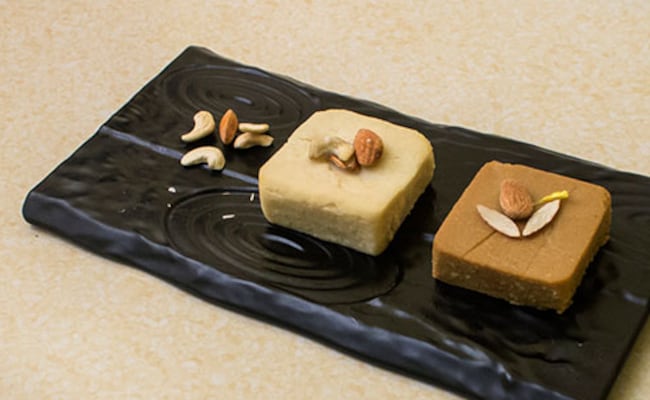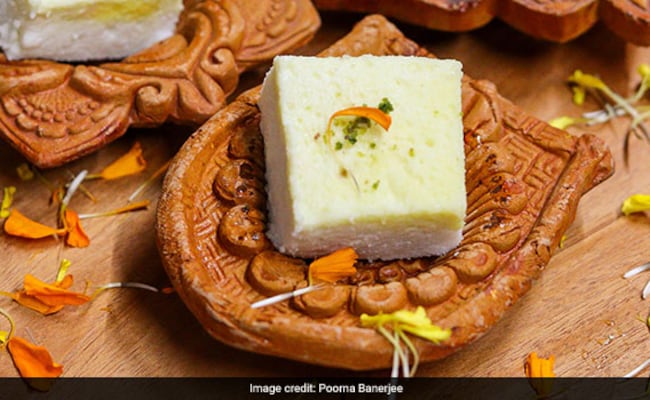Experimentation with food has always been a bit of a conversation starter, and that’s what the Ice Cream Sandesh was during the mid to late-1990s. Evenings, especially Saturday or Sunday evenings, would often be the time for friends and relatives to visit. A box of sweets would almost always be carried and presented to the host, sometimes to be consumed amongst the then-present company saved for posterity. For mishti has always been considered to be quite an appropriate gift to give the host, like a bottle of wine or a bouquet in other parts of the world.
The late 1980s and all through the 1990s saw, among other things, a sharp rise in the purchase of electronic goods and gadgets. Televisions became cheaper, washing machines and dishwashers were no longer seen and sighed over in glossy magazines, and the refrigerator became a huge part of most urban and suburban households, the myths around refrigeration and loss of nutrition reducing significantly thanks to aggressive marketing by companies through different channels and these products’ general usefulness that increased the efficiency of the household significantly. With the advent of the refrigerator also came certain items that gained popularity by leaps and bounds. One of them was the ice cream, a frozen treat that would be kept inside the freezer and eaten as a treat, and its popularity also increased significantly when, in weddings or other formal occasions, along with sweets ice cream would be provided as an alternative to mishti doi or kulfi.
Also Read: Watch This Fun, Chocolate(y) Spin On Sandesh, The Traditional Bengali Sweet

Sandesh
With the rapid popularity of ice cream as an alternative to mishti for dessert, the dessert scape of West Bengal was forever changed with the introduction of the Ice Cream Sandesh, which aimed to emulate the flavours of ice cream while retaining the integrity of a sweet. Kept cold, this sweet would be touted as the perfect combination of a cold, sweet treat that would both be sweet and ice cream together. Though my then-child-self had vociferously protested against this misnomer (I was a rather opinionated child), because the texture would be wildly different from ice cream, it did raise a certain degree of curiosity.
“It is essentially bhapa (steamed) Sandesh, something we had already had in our culinary dictionary. What made it special was the fact that the sweet shop owners would recommend it to be eaten and served cool, if not cold. Also, it was perhaps the first mishti to be flavoured with vanilla and strawberry, and also, Dwarik would make a version of it which was sugar-free and flavoured with saccharine, and it was probably the only option for many diabetics who would be craving sugar. As much as I remember, there would be a two-in-one flavoured Ice Cream Sandesh which would mimic the two-in-one ice cream, right down to the artificial pink colour on top and white bottom,” food blogger Debjani Chatterjee Alam noted. Several other sweet shops had also come up with versions of the Ice Cream Sandesh, and one of the oldest contenders was Girish Chandra Dey & Nakur Chandra Nandy, which is a legendary sweet shop that specialises in Sandesh solely.
Also Read: ‘Immunity Sandesh’ – This Viral Bengali Sweet Is Made With 15 Immunity-Boosting Herbs And Spices
“We definitely started making the ice cream Sandesh before 1996, though we don’t exactly remember when. We sell it by the gram rather than by piece, and we are often asked to customise it according to the customer’s taste. In winter, we make a version with Nolen gur and that’s fabulous. The texture is quite different from regular Sandesh, and that’s because of the pak, or the way it’s prepared,” observed Pritid Nandy, one of the partners at Girish Chandra Dey & Nakur Chandra Nandy. “The texture is not as ‘tight’ as the Sandesh, but it has got a very creamy texture and flavour, which is why it is called ice cream Sandesh because it melts in your mouth.”
The entrance of the Ice Cream Sandesh and its ilk into the Bengali mishti-scape did have a great deal of consequence. Sweetshop owners started experimenting with textures and flavours and tried to add interesting twists to their sweets. One such early entrant would be the Chocolate Sandesh, which Cadbury would pick up a couple of decades later to run a successful campaign involving Cadbury sweets and the sweet shops of Bengal, urging sweet makers to experiment with Cadbury chocolates. In time, thought processes such as this would also be transmitted to creating fusion sweets that would be combining available local ingredients and add techniques that would be global. This paved the way for the baked roshogollas, Nolen gur mousse or the mihi dana cheesecakes that are now created often in sweet shops and restaurants alike.
However, many sweet shops restrict themselves from such experiments, partly because of the pride they have in their products and the unwillingness to introduce new methods or techniques that may hamper the production line. “Most of our sweets remain unchanged from their original recipe,” said Lahana Ghosh of Jugal’s Sweet Shop. The 98-year-old establishment has remained true to most of its original sweet recipes but has started venturing out into a few fusion sweets, including the Ice Cream Sandesh. “The version we make is a very simple one with saffron and rose flavouring, but many other places do different versions like vanilla and two-in-one. We like keeping ours as close to the essence of ‘mishti’ as we can since we feel that our strength is in our recipes that have stood the test of time and stuck to the Bengali roots with which we had started our first shop. Even this recipe is quite old, about 25 years or so at least. We don’t make it very sweet because we feel that a good Ice Cream Sandesh should be moderately sweet and you can also adjust the sweetness as per your taste. You can also skip the sugar and add your choice of sweetener and make this healthier, too.” The recipe provided with this post is Jugal’s version of the Ice Cream Sandesh which is flavoured with rose and saffron. The quantity of sugar provided here is a suggestion and can be adjusted as per taste or replaced with artificial sweetener too.
Bhapa Ice-cream Sandesh Recipe
Recipe by: Jugal’s Sweet Shop

Sandesh Ice Cream
Ingredients
- 750 ml. fresh cow’s milk
- 1/3 cup Curd
- 2 teaspoon Green Cardamom powder
- 2 teaspoon Rosewater
- 75 gm. finely crushed sugar, or as per your taste
- 1/2 teaspoon Ghee for greasing
- For garnishing
- 4-5 Chopped cashew nuts
- 1/2 teaspoon saffron strands
Method
- First, make chhena (cottage cheese). For this, take the milk in a heavy-bottomed vessel in medium heat.
- Beat the curd. Keep it aside.
- When the milk starts bubbling slowly, add the curd and stir it in well.
- Within few minutes you can see milk starts curdling properly and then switch off the flame.
- When it curdles completely, strain the whey using a muslin cloth. Don’t squeeze the cloth too much because that will make hard chhena and not soft, which is what you will need.
- Take the chhena in a mixing bowl and mash it very well using your hand.
- Add all other ingredients with chhena and mix it very well. Then, make a soft dough using your hand.
- Grease your metal tin with ghee where you can steam the chhena.
- Pour the dough into it. Ensure it is in a flat layer. Cover with aluminium foil.
- Steam the dough for 25 minutes. Let it cool to room temperature and then keep it to freeze for 2 hours.
- Demould it and cut it up into pieces.
- Garnish with chopped nuts and saffron strands.
Stay connected with us on social media platform for instant update click here to join our Twitter, & Facebook
We are now on Telegram. Click here to join our channel (@TechiUpdate) and stay updated with the latest Technology headlines.
For all the latest Health News Click Here
For the latest news and updates, follow us on Google News.
